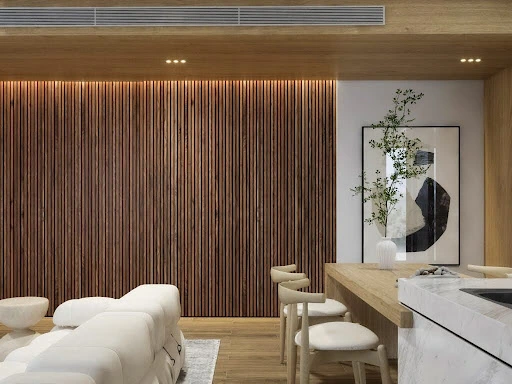How To Install Wood On Walls?

One of the primary hurdles in mounting wood on walls is preserving its long-term aesthetic appeal against environmental influences like moisture and material expansion. Installing wood on walls is an art that requires careful attention to ensure both aesthetics and durability over the years. In this article, we will guide you through the necessary steps to successfully accomplish “How to install wood on walls“.
Choosing where to install
Choosing the best spot for the installation of wood on walls is a very important process. First, establish your purpose. Do you want to have something bold in the living room, or maybe a little warmer in the bedroom? The purpose will lead to the method that will be used in each space.
Consider also the natural light in the room. The wood normally shines in the glow of the natural light, courtesy of its natural color and grain, hence the walls near the windows should be a prime choice. If there isn’t much natural light in the room, then the consideration of what artificial lighting could do to enhance the wooden walls in that respect becomes necessary.
Also put into consideration the humidity in the surrounding. Wood tends to expand, warp, or deform when subjected to high or fluctuating levels of humidity. Choose low and stable humidity spaces that are also likely to guarantee the durability of the wood.
Finally, make sure that the installation of wood will match the style of the house. A wooden wall is either a complement or an eyesore in your house; this all depends on how it is incorporated with the existing interior design. Carefully select a design to yield a harmonious and visually impressive room.
Prepare your planks
Preparing wood planks for wall installation requires precision and care. First, you need to choose the appropriate type of wood. This would call for exact decision-making with regard to the type of wood planks to be used. The most popular choices of wood are the qualities of being durable, beautiful, and stable on the wall—oak, pine, or mahogany for wall paneling.
Once the wood type is chosen, properly measure the dimensions and bring home the wood to the amount your design demands.
Before installing, the wood planks should be made ready; this has to be done to the surface of wood so that the rough edges and other imperfections are touched up in order to prevent any accidents or to keep it looking good when anybody comes in contact with it. You can also treat the wood with protective paint or oil, which not only makes it durable but also more resistant to environmental conditions.
Also, all the planks of wood that have been prepared are again examined to see to it that they are of good quality and that they do not have any marks or defects from termites. Preparing the planks of wood properly lays a good foundation, and it is expected that successful installation will take place on this foundation.
Nail the planks in place
One of the most important processes in “how to install wood on walls” is nailing the planks in place. You should mark the location where you want the planks to be installed on the wall. Maker uses measuring tape and a pencil to make sure that the marks made are accurate, so the installation of the planks will be straight and even.
Before you start nailing, make the wall stud’s location known with a stud finder or framing detector to ensure you already know the studs or wall frame locations where you are going to nail. This work helps you prevent nailing through any electrical wire or pipe.
Once the safe points have been located, holes are pre-drilled in the wall at the marked points by means of a drill. This will facilitate the nailing and avoid any damage to the wall from cracking or splitting while being nailed. You must select the nails or screws that fit the type of wall and are long enough to hold the wood planks very securely.
Finally, you put the wood planks on the pre-drilled points and nail them down to the wall with the use of a hammer or nail gun. The installer needs to check whether the wood planks are nailed firmly before he proceeds to the next wood planks.
Cut out light switch and outlet gaps
This may be very painstakingly prepared in the installation of woods on walls, most especially when the aesthetics and functionality of the space are to be considered—in the integration of light switch and outlet gaps. Here are the steps that you should follow in correctly cutting light switch and outlet gaps.
First, position the lights and outlets on the wall, then mark these positions on the wood panels by tape measure and pencil; don’t allow these positions to be covered after the wood is installed and at the same time make sure that these positions are really comfortable for daily usage. The same should be done with the 3d wall panels.
Use a hole saw or a drill bit designed for this to cut around the marking. Be cautious not to cut too close to the wood panels, as this will damage them, causing irregular shapes that will affect the aesthetics and safety of the completed wall.
After cutting the material, sand the cut edges with fine sandpaper to avoid sharp corners and rough edges that may be hazardous. This can help secure the electrical wires and other electrical gadgets during installation and also add onto the overall beauty of the project.
The last thing, the installer needs to test fit electrical appliances such as lights and outlets into the newly created gaps to fit exactly. This assures that devices like lights, outlets etc. will fit into place neatly and conduct safely with no kind of problem in connection or installation.
Apply finishing touches
After the installation of wood on the walls and the slot cutting for lights and outlets, the final touch will be the application of the finishing touches to protect and make the material look appealing.
You have to thereafter inspect the entire surface for the cuts, scratches, or any other technical defect. By the use of a fine sandpaper, smoothen out all corners and surfaces, and all the minor flaws will have been removed.
After it is done, then a single coating of paint or protection must be done for the wood. You should select a product keeping in mind the wood type and indoor conditions, for example, the products can be the water-based paint, or natural protective oil finishes. The coat can enhance the aesthetic value of wood and protect it from moisture damage and temperature change.
Finally, install all accessories properly and make them work effectively, including lighting and outlets. Touches of finish will certainly extend the life of wood and sustain the beauty of a wood wall for a lot of years.
Conclusion
It is for this reason that the installation of wood on walls needs to be detailed to have the material looking presentable and beautiful for a long duration. Adhere to “how to install wood on walls” as discussed above and be sure of enjoying the living space with long-lasting and impressive decorative wood.
Are you looking for an installation of wood that is both great-looking in design and very durable? Well, Woodywalls is there for you. Contact us now to explore the best solutions and start renovating your living space!
